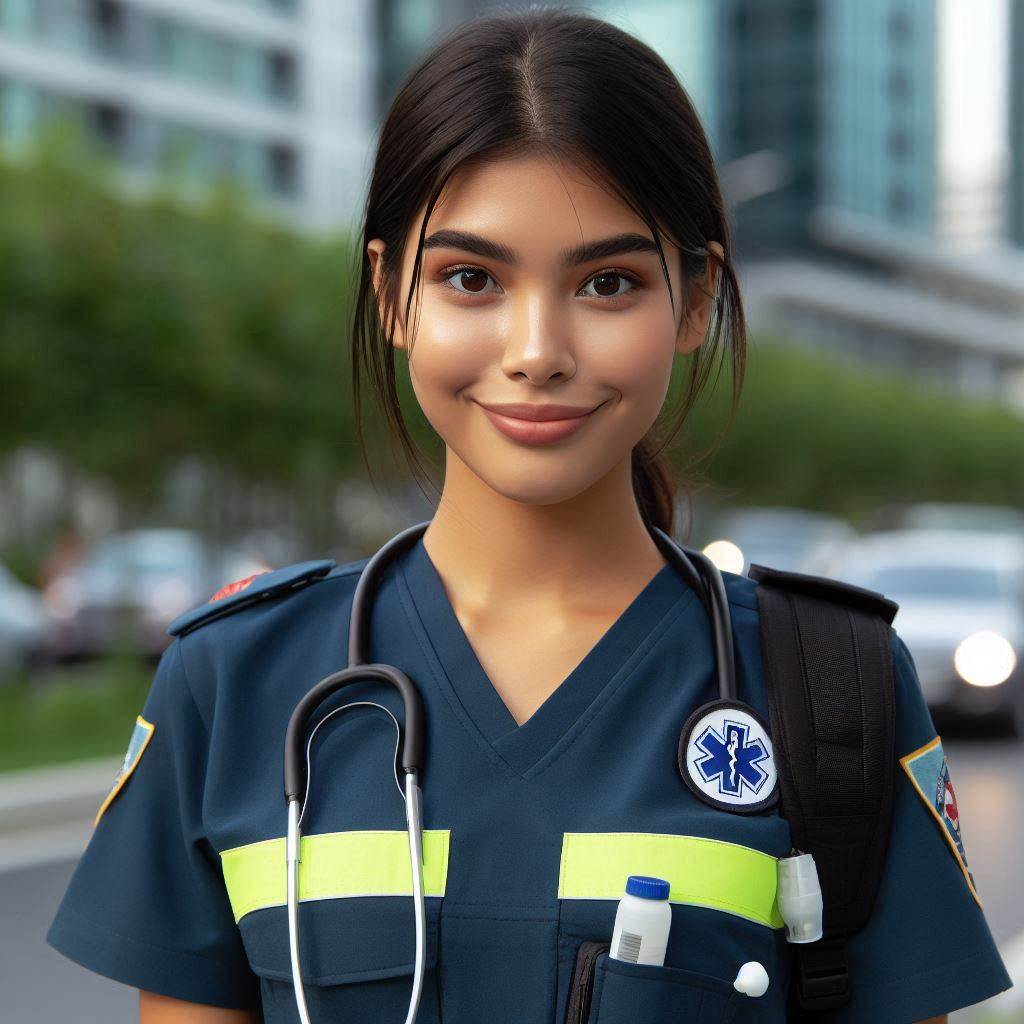Introduction
Paramedics play a crucial role in emergency medical services. They provide immediate care in critical situations.
Paramedics are often the first to arrive at accident scenes. Their swift actions can mean the difference between life and death.
They stabilize patients and provide essential medical interventions. Paramedics transport patients to hospitals, ensuring continuity of care.
Their expertise and quick thinking save countless lives daily.
The importance of paramedics cannot be overstated. They bring advanced medical care to the field, beyond basic first aid.
Paramedics handle various emergencies, from heart attacks to severe trauma. They work under immense pressure and make rapid decisions.
This role requires extensive training and dedication. Paramedics’ ability to remain calm in chaos is vital.
To illustrate their impact, we will share real stories. These stories highlight the heroic efforts of paramedics.
They showcase the life-saving skills and compassion paramedics offer. Through these accounts, the true value of paramedics becomes clear.
Each story represents countless others occurring daily worldwide. Paramedics are unsung heroes, deserving of recognition and respect.
The Quick Response Time of Paramedics
When it comes to saving lives, every second counts. Paramedics are trained to respond quickly to emergency situations.
Importance of Quick Response Times
- Quick response times can mean the difference between life and death.
- Immediate medical intervention can prevent a patient’s condition from deteriorating.
- Paramedics need to be on the scene as soon as possible to provide critical care.
- Efficient response times lead to better outcomes for patients in emergency situations.
Real Story of Swift Response
One day, a paramedic received a call about a car accident on the highway. Without hesitation, he rushed to the scene.
Upon arrival, he found a critically injured driver trapped in the vehicle. The paramedic acted swiftly, administering first aid and stabilizing the patient.
Thanks to his quick response, the driver was safely extricated from the wreckage and transported to the hospital for further treatment.
The paramedic’s actions saved the driver’s life.
Training and Skills
- Paramedics undergo extensive training to handle various medical emergencies.
- They are equipped with knowledge of advanced life support techniques.
- Paramedics are trained to make quick decisions in high-pressure situations.
- Continuous training and skills development ensure that paramedics are prepared to act fast and effectively.
Read: Training Programs for Aspiring Home Health Aides
Life-saving Interventions
Various interventions paramedics can perform to save lives
Paramedics are trained to perform a variety of interventions to save lives in emergency situations.
These interventions can range from basic life support techniques to advanced critical care procedures.
Here are some of the key interventions that paramedics can perform:
- Cardiopulmonary Resuscitation (CPR): One of the most crucial interventions that paramedics perform is CPR.
CPR involves chest compressions and rescue breaths to help maintain blood flow and oxygenation to vital organs. - Defibrillation: Paramedics use defibrillators to deliver an electrical shock to the heart in cases of cardiac arrest.
Defibrillation can help restore the heart’s normal rhythm and save a patient’s life. - Airway Management: Paramedics are trained to establish and maintain an open airway in patients who are having difficulty breathing.
This may involve techniques such as inserting a breathing tube or using a bag-valve mask. - Medication Administration: Paramedics can administer a variety of medications to patients in order to treat conditions such as pain, allergic reactions, and cardiac arrhythmias.
Quick and appropriate medication administration can be life-saving in many situations.
Real Story: CPR Saves a Life
One paramedic, Sarah, responded to a call about a man who had collapsed in a park. Upon arrival, she found the man unresponsive and not breathing.
Transform Your Career Today
Unlock a personalized career strategy that drives real results. Get tailored advice and a roadmap designed just for you.
Start NowWithout hesitation, Sarah immediately started performing CPR, following the guidelines she had been trained in.
After several minutes of chest compressions and rescue breaths, Sarah was able to revive the man.
He started breathing on his own again and regained consciousness before being transferred to the hospital for further evaluation.
Sarah’s quick actions and effective CPR skills saved the man’s life that day.
Equipment and Tools for Critical Care
Paramedics rely on a range of equipment and tools to provide critical care to patients in emergency situations.
Some of the essential equipment used by paramedics include:
- Defibrillators: These devices are used to deliver an electrical shock to the heart in cases of cardiac arrest.
- BVM (Bag-Valve-Mask): A handheld device used to provide ventilation to patients who are having difficulty breathing.
- Oxygen Delivery Systems: Paramedics carry oxygen tanks and various delivery systems to help patients who are experiencing respiratory distress.
- Advanced Airway Devices: Equipment such as endotracheal tubes or supraglottic airways are used to establish and maintain an open airway in patients who are unable to breathe on their own.
- Medication Kit: Paramedics carry a range of medications to treat various medical conditions, including pain, cardiac emergencies, and allergic reactions.
By having access to these critical tools and equipment, paramedics are able to provide lifesaving care to patients in a timely and efficient manner.
Their quick thinking, expert skills, and the use of advanced equipment make a significant difference in saving lives during emergencies.
Read: Home Health Aide Salary: What to Expect
Teamwork and Communication
Importance of teamwork among paramedics and other first responders
Teamwork is essential in emergency situations, as paramedics often work alongside other first responders to save lives.
Collaboration with firefighters and police can greatly enhance the effectiveness of emergency response.
Paramedics rely on the expertise of other professionals to ensure timely and efficient care for patients.
Real story of paramedics coordinating with firefighters and police to save a life
One real-life example of effective teamwork involves a paramedic unit responding to a car accident on a busy highway.
Upon arrival, they discovered a passenger trapped in the vehicle, requiring immediate extraction.
The paramedics quickly assessed the situation and coordinated with the firefighters and police on scene.
Together, they worked seamlessly to extricate the patient safely and stabilize them for transport to the hospital.
This collaboration not only saved the individual’s life but also showcased the importance of teamwork in high-pressure situations.
How effective communication can make a difference in emergency situations
Effective communication is another crucial aspect of paramedic work, as clear and concise information exchange can mean the difference between life and death.
Paramedics must relay vital patient details to hospital staff to ensure continuity of care.
Showcase Your Business Today
Reach thousands of readers actively exploring professional services. Publish your business profile and grow your audience now.
Publish NowClear communication among team members during emergencies can prevent errors and streamline the rescue process.
In another scenario, a paramedic team responded to a cardiac arrest call at a local residence.
Upon arrival, they found the patient unresponsive and immediately began resuscitation efforts.
The paramedic in charge efficiently communicated instructions to team members, assigning roles and providing updates on the patient’s condition.
This seamless communication allowed for effective teamwork and ultimately led to the successful resuscitation of the patient.
Without clear and efficient communication, the outcome could have been drastically different.
Overall, teamwork and communication are fundamental components of paramedic work that can save lives in critical situations.
By emphasizing collaboration and effective information exchange, paramedics and other first responders can ensure the best possible outcomes for their patients.
Read: Daily Responsibilities of a Home Health Aide

You Might Also Like: Day in the Life of an Ultrasound Technician
Learn More: Building a Private Practice in Recreational Therapy
Dealing with Trauma and High-pressure Situations
Challenges paramedics face when dealing with traumatic injuries and high-pressure situations
- Paramedics face immense challenges when dealing with traumatic injuries and high-pressure situations.
- They must remain calm and focused, quickly assessing the situation and providing life-saving care.
- In a chaotic situation, a paramedic shared a real story of how she stayed composed and managed multiple critical patients.
- She prioritized tasks, communicated effectively with her team, and made split-second decisions to save lives.
Mental resilience and coping mechanisms paramedics use to stay effective
- Paramedics have to develop mental resilience to cope with the stress and emotional toll of their job.
- They use coping mechanisms like debriefing sessions, peer support, and mindfulness techniques to stay effective.
- Paramedics also rely on strong teamwork, trust in their training, and a sense of purpose to overcome challenges.
- Staying physically fit, getting enough rest, and seeking professional help when needed are essential for their well-being.
Ultimately, paramedics play a crucial role in saving lives, and their ability to handle trauma and high-pressure situations with professionalism and resilience is truly remarkable.
Read: Phlebotomy Job Market: Demand and Opportunities
Transporting Patients to Hospitals
When paramedics respond to an emergency, their main goal is to stabilize the patient and transport them to the hospital as quickly and safely as possible.
The transportation process is crucial in ensuring that patients receive the continued care they need to increase their chances of survival.
Process of Transporting Patients to Hospitals
Upon arriving at the scene, paramedics assess the patient’s condition and provide immediate medical assistance.
If the patient requires transportation to the hospital, they are carefully transferred onto a stretcher and loaded into the ambulance.
Paramedics secure the patient in the ambulance and begin monitoring their vital signs to ensure stability during transport.
During the journey to the hospital, paramedics continue to provide medical treatment based on the patient’s condition.
Real Story of a Paramedic Stabilizing a Patient en Route to the Hospital
One particular incident that stands out is when paramedic Sarah responded to a call about a car accident.
Upon arrival, Sarah found a driver trapped inside the vehicle, suffering from severe injuries.
She quickly assessed the situation, stabilized the patient, and worked with the rescue team to extricate the driver from the wreckage.
Once the patient was freed, Sarah carefully transferred him onto the stretcher and into the ambulance.
Throughout the journey to the hospital, she continuously monitored his vital signs, administered pain relief medication, and reassured him to keep him calm.
Thanks to Sarah’s quick thinking and expert care, the patient arrived at the hospital in stable condition.
Importance of Continued Care During Transportation
Transporting patients to the hospital is a critical phase in their medical treatment.
Paramedics must ensure that patients receive continuous care to prevent any deterioration in their condition.
The ambulance serves as a mobile medical unit where paramedics can administer necessary medications, monitor vital signs, and provide comfort to patients.
Continued care during transportation helps improve patient outcomes and increases the chances of successful treatment at the hospital.
Overall, the process of transporting patients to hospitals in ambulances is a vital part of emergency medical care.
Paramedics play a crucial role in providing continued care during transportation, ensuring that patients receive the necessary treatment until they reach the hospital for further medical intervention.
Conclusion
Paramedics are the unsung heroes of our communities. They are the first responders in emergencies, providing life-saving care on the frontlines.
Their quick thinking, medical expertise, and dedication make a significant impact on the outcomes of critical situations.
By sharing real stories of how paramedics save lives, we can appreciate the crucial role they play in our society.
It is important to support and show gratitude towards paramedics for their selfless service and sacrifices.
Next time you see an ambulance rushing by, remember the heroes inside who are working tirelessly to save lives.
Let’s show our support for paramedics in any way we can.
[E-Books for Sale]
The Big Book of 500 High-Paying Jobs in America: Unlock Your Earning Potential
$19.99 • 500 High-Paying Jobs • 330 pages
Explore 500 high-paying jobs in America and learn how to boost your career, earn more, and achieve success!
See All 500 High-Paying Jobs of this E-Book
1001 Professions Without a Degree: High-Paying American Jobs You Can Start Now
$19.99 • 1001 Professions Without a Degree • 174 pages
Discover 1001 high-paying jobs without a degree! Unlock career tips, skills, and success strategies for just $19.99!




